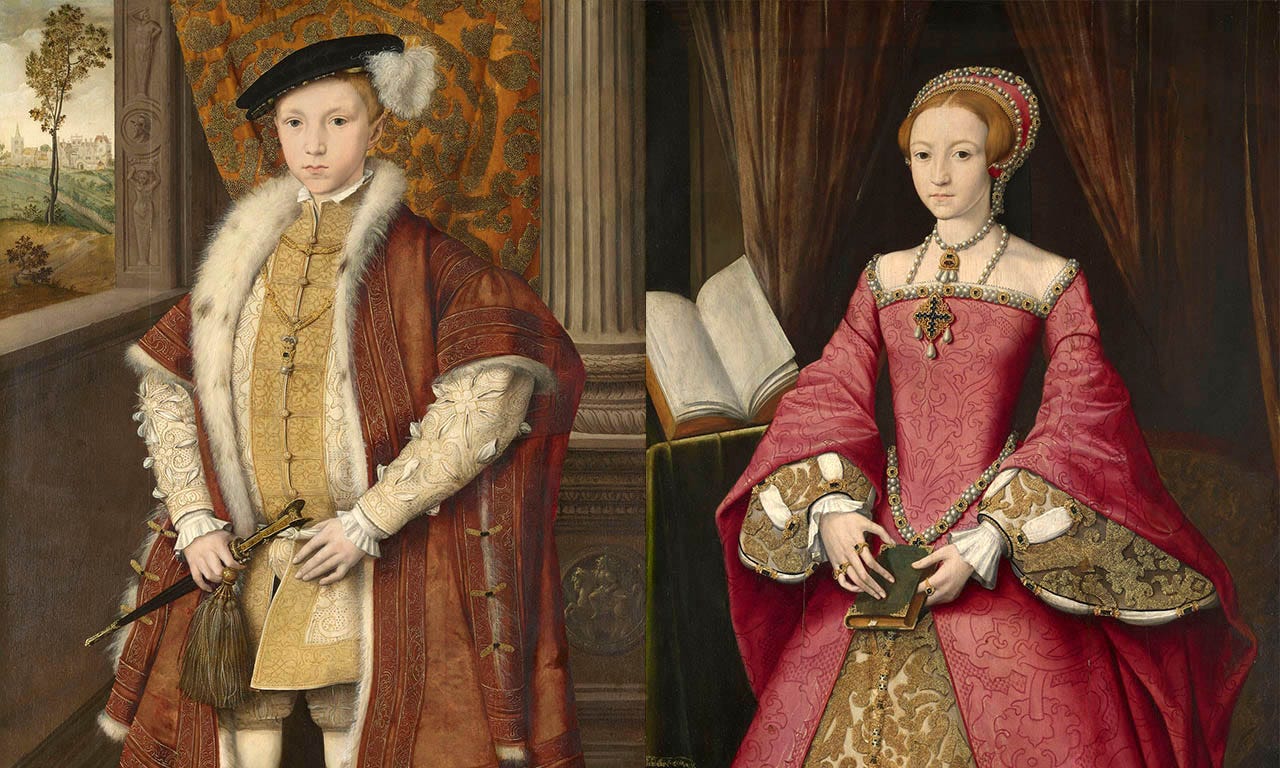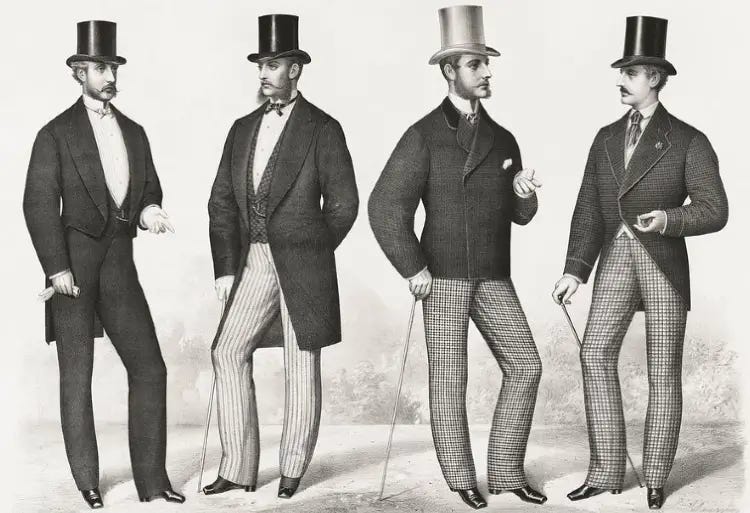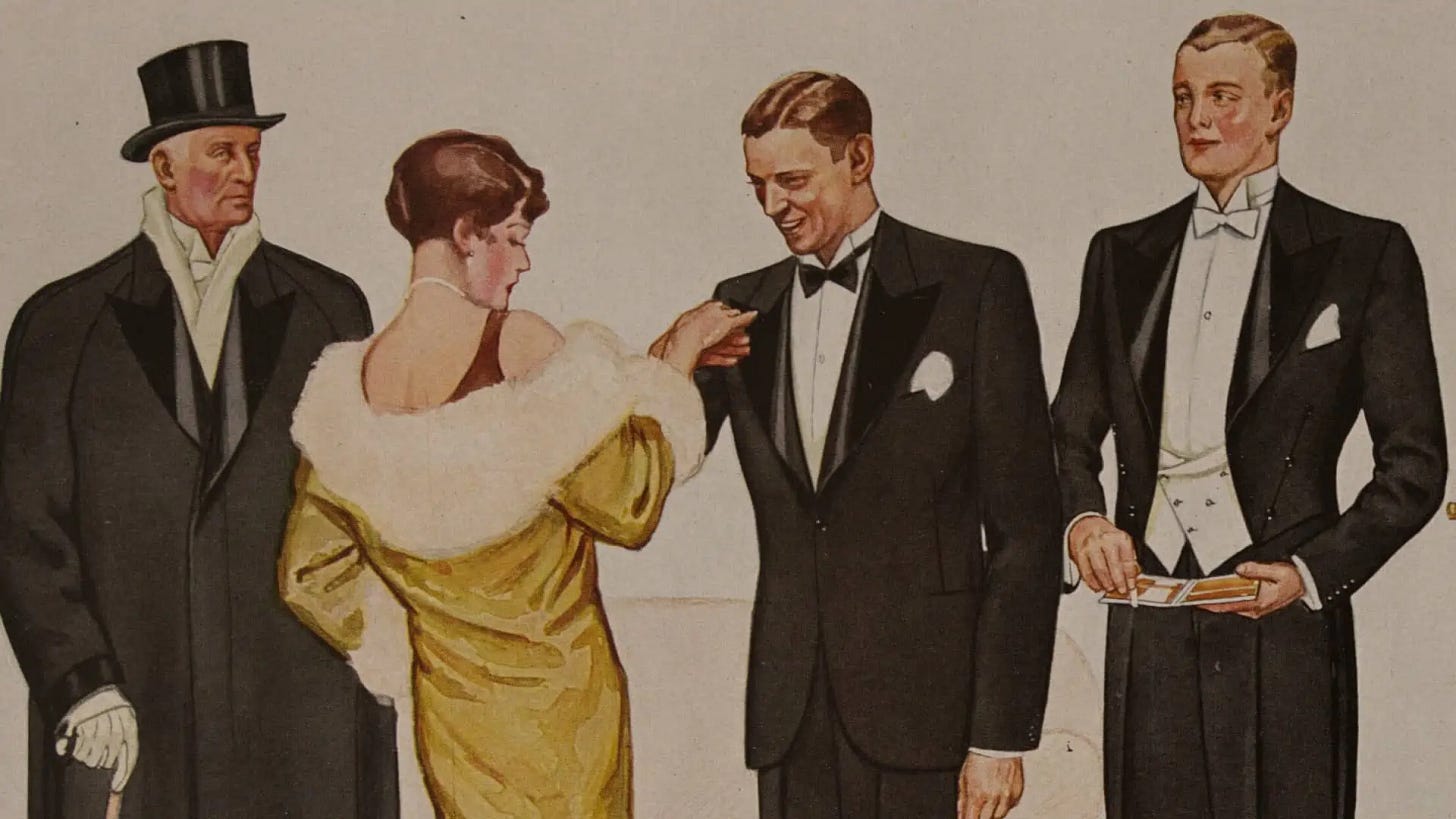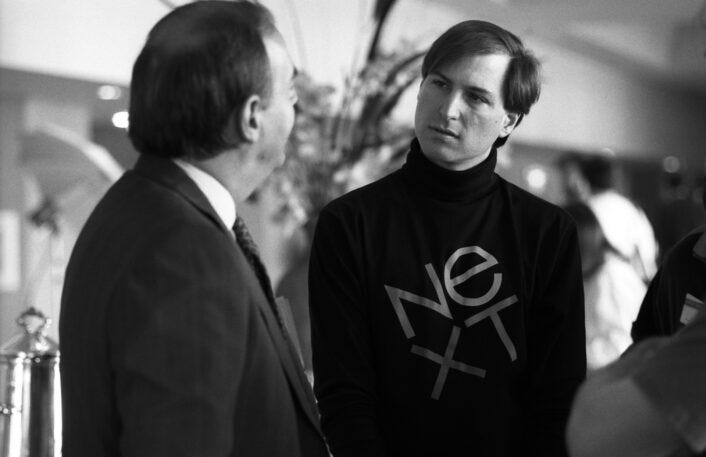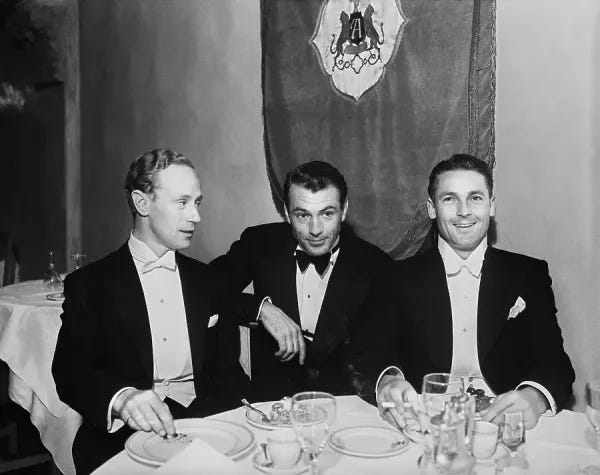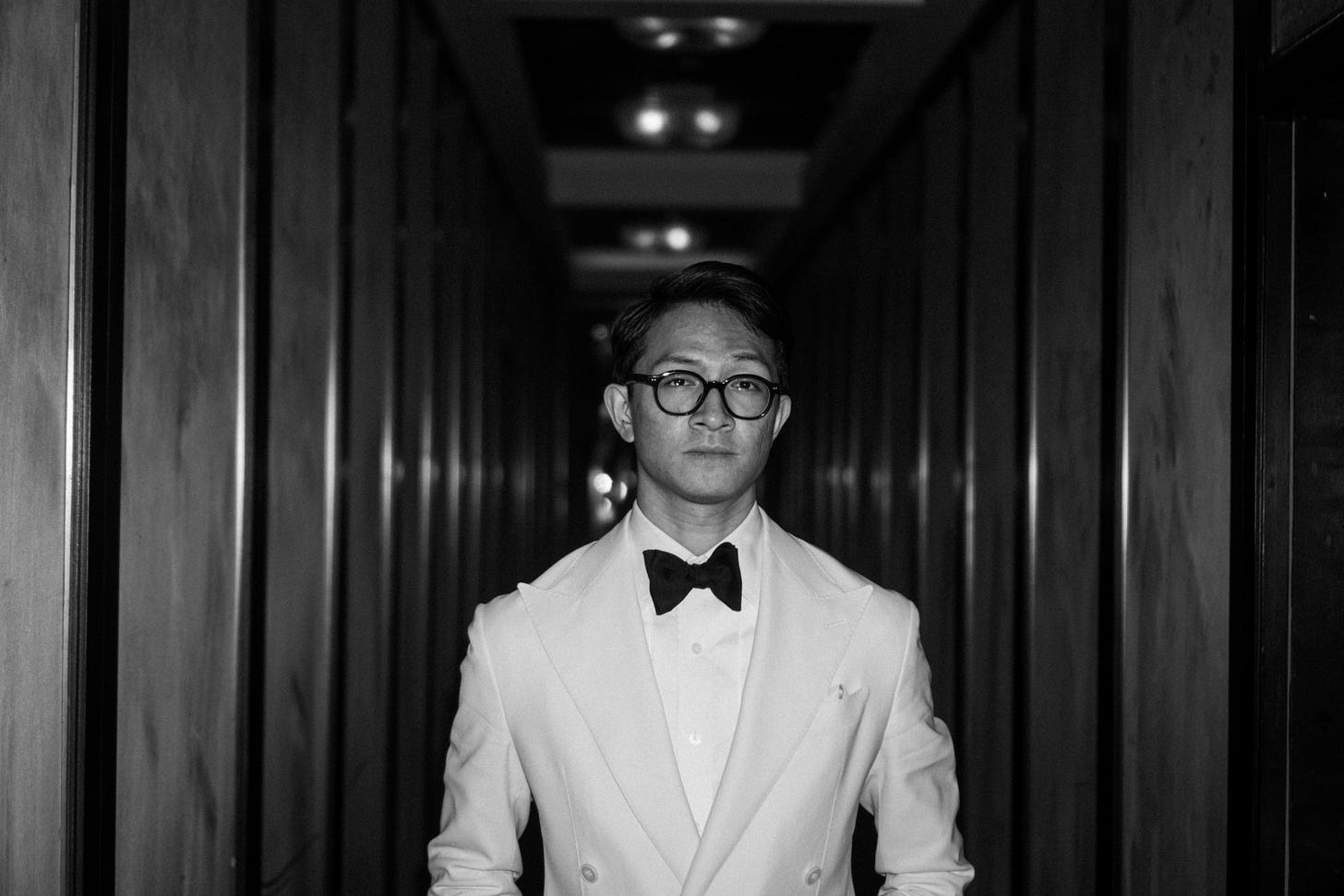Why Men Stopped Dressing for the Evening
And Why the Black Tie Deserves a Quiet Renaissance
Recently, there’s been a recurring thought on my mind.
It’s an idea that came from a conversation I had with my long-time friend over a glass of Gin Rickey.
I asked him about the feeling he had when wearing the vintage grey windowpane sport jacket — made of Loro Piana fabric — that I gave him as a present, for the first time…
And what he told me was: “A little discomfort.”
Not in the physical sense, but on a mental level.
It’s a feeling that, while the jacket fit him perfectly, made of a luxurious mill like Loro Piana, discreetly elegant with its windowpane blue pattern on grey… something inside of him was unsettled.
By zooming out and looking at the big picture — this clearly resonated with the psychological concept of cognitive dissonance — the mental discomfort experienced when holding conflicting beliefs, values, or behaviors.
Now, this good friend of mine… he’s a man who grew up with everything that this overly casual society has lied to him about:
You don’t need to put any intention into dressing as a man.
Elegance is merely an act of ostentation — reserved for insecure people.
Standing out with grace is not a noble act. Conforming with casual is how you belong to society.
When he decided to wear the tailored jacket for the first time — even in an appropriate context like an evening dinner with clients and executives…
His identity had not yet been built for the effect that the jacket offered him.
It demanded intention, confidence, and aspiration… traits that are missing in the character of modern men.
Combine this with the cultural perception that injects a specific idea into tailored jackets or leather footwear — that they are sacred garments for social events, not daily wear — and you enhance the phenomenon behind why modern people seem to want to look good… but somehow cannot bring themselves to put in the effort or reach that state on a daily basis.
So this is the first takeaway I’ll give to all of you:
“The way you naturally dress is a subconscious reflection of your inner identity.”
Let me elaborate on this statement…
Human nature loves to outsource cognitive functions to the automation part of the mind — which regulates behavior through routine and aligns it with one’s internal nature, forming patterns in a way of life.
Just like how people shower, brush their teeth — or perform their daily routines without needing to think.
Dressing, for many, is the byproduct of this automation — a reflection that allows the identity, the subconscious mind, to take over and choose what they believe best represents who they are.
Now, if I ask you — how does a man develop his identity — what would you say are the contributors?
Society. Media. External exposure as a whole.
That’s why, in this overly casual society, the internal identity of the modern mass will always contain comfort and casualness as core elements.
In contrast, the deliberate act of wearing sartorial garments — of putting intention into building an image, of striving to become a higher version of oneself — is a counterforce against the norm and the identity of the modern mass.
So… my words here are this:
If you want to effortlessly dress well — without worrying whether you’re being seen as an imposter or pretentious — do the inner work. Craft your ideal identity. And use clothes as a gateway to become him.
Speaking of ideal identity — here comes the heart of this video.
When you look back at the images and visuals of ladies and gentlemen —
Apart from the class they exuded, the mannerisms in their interactions, and the high standard of presenting oneself — all the virtues modernity seems to have forgotten…
There is another virtue:
The idea of evening wear — the symbol of a life well lived.
How Evening Wear Was Invented and How It Faded
Evening wear, like other sartorial terminology, was invented in Europe — and it all started during the age of nation-states in the post-16th century.
If you’ve ever had a chance to watch period films set between the 1600s and 1800s, you probably noticed how men dressed in those days.
Extravagant, detail-oriented, performative — think of the Shakespearean age during Queen Elizabeth I — that’s the landscape.
The purpose, originally, for evening wear at that time was as an elaborate extension of daywear, typically involving powdered wigs, embroidered frock coats, breeches, and heeled shoes.
It was a set of garments for aristocratic men and women to wear for dinner, the opera, or salons — with strict adherence to status-bound codes.
A declaration of one’s place in the social order, so to speak.
However, during the late 18th century, one name acted as the catalyst for shifting the norm of evening wear — and the world of menswear as a whole — toward modern, minimal, and subtle elegance: George Bryan “Beau” Brummell, a name I believe some of you are already familiar with.
Beau Brummell was a middle-class Englishman who lived during the Regency Era in the late 18th to early 19th century.
He was well known for his unmatchable taste in living — dressing included.
What he did at that time, and what still echoes through the modern sartorial scene, was to reduce, exclude, and streamline the bold, extravagant garments worn by men.
Cleanliness and silhouette over unwieldy excess.
Wool over silk.
A form-fitting tailcoat in subtle color with a crisp cravat over embroidered coats.
There are plenty of fascinating stories about this man — or I should say, this Dandy of the Regency — and if you’re interested in that, I recommend checking out this video from Gentleman’s Gazette or this one from Sartorial Talks, if you haven’t watched them already.
Now, due to Beau Brummell’s charisma and his direct social connection to the Prince of Wales (later King George IV), his influence gained tremendous leverage and exposure among England’s high society.
That was the turning point — when evening wear became darker, more austere, and more structured. The tailcoat emerged as the default for formal evening events.
This gave birth to the epitome of the formal dress code — White Tie, which included:
A black tailcoat
A white low-cut waistcoat
A white cotton piqué bow tie
A stiff-front shirt with a wing collar
Patent opera pumps
This came with the expectation — and the cultural obligation — that any man with means and social standing must don this ensemble for every evening social event.
And as I’ve mentioned many times before about human nature clinging to comfort — White Tie eventually became a victim of casualization.
That’s when the birth of the dinner jacket occurred.
This garment — a shortened coat for evening — was one of many sartorial inventions attributed to King Edward VII of Britain.
From the buttoning rule of fastening only the top or middle button (not the bottom), to the popularization of cuffed or turned-up hems on tailored trousers — these are all credited to Edward VII.
Now, for the background story of the dinner jacket:
He wanted a more casual coat for evening wear — something appropriate for dining at his private country estate, without the full formality.
So he asked his tailor, Henry Poole of Savile Row, to create such a garment.
And that is when the dinner jacket was first officially recorded.
Since then, the story goes that an American socialite named James Brown Potter had a chance to visit the Prince of Wales (later Edward VII), and was inspired by the garment.
He commissioned the same piece and brought it back to American high society in the late 19th century — specifically at a private social club called The Tuxedo Club.
Whether this story is entirely true or not, the term Tuxedo became the associated name for the dinner jacket in the United States — and it carved its own place in eveningwear as the staple known as Black Tie, from the early to mid-20th century across the globe.
During those years, it was almost a societal doctrine:
If by 6 p.m. — when dusk arrived — you saw a man on the street without a dinner suit, he either had just finished work and was going home, was heading to a private casual event, or simply didn’t have the money to own one.
The core reasons why Western society — especially in the U.S. from the 1910s to 1950s — became so attached to the idea of evening wear can be summarized in these ideologies:
Cultural & Social Drivers
Since evening wear was directly rooted in European traditions, it was seen in the U.S. as a mark of refinement, civility, and adherence to societal decorum.
It reflected a broader cultural aspiration toward order, ritual, and respectability.
Class & Aspiration
Evening wear became a symbol of economic success and upward mobility.
For the rising American middle class, owning a tuxedo signified one had entered the ranks of the respectable — mimicking the elite’s sartorial codes.
Cinematic Influence
Hollywood’s Golden Age mythologized the tuxedo as the costume of the ideal man — charming, elegant, powerful.
Icons like Fred Astaire and Cary Grant turned formalwear into a glamorous, aspirational image for millions.
Cultural Rituals
Daily life was punctuated by events that demanded formal dress — dinners, theatre, weddings, and galas.
Eveningwear functioned as a social uniform that structured and elevated these experiences.
Response to Hardship
During the Great Depression and World War II, dressing formally became an act of dignity and escapism.
It offered a sense of control and pride when the world around was uncertain or crumbling.
Gender & Identity
The tuxedo reinforced ideals of masculine order, restraint, and responsibility.
Eveningwear became part of the cultural script for what it meant to be a respectable, grown man in mid-century America.
All of these ideologies ingrained the ritual, tradition, and way of life for gentlemen of the era — until the arrival of counterculture, which acted as the catalyst for breaking down these beliefs, year by year.
It deleted the norm of wearing suits, leather shoes, and of course, the dinner jacket by evening.
If you want to learn more about the true influence of the counterculture movement in the late 1960s — which still echoes into modern-day society — then I recommend checking out this essay after finishing this one.
But the undeniable result of that catalyst is the gradual decline of evening wear in society.
Enhanced by the rise of tech culture from the 1990s to today — and all you see is the holy trinity of worshipping utility, casualness, and comfort — all over class, refinement, and tradition.
Moreover, with the modern lifestyle blurring the barrier between work and rest, daytime and nighttime — life is now more dynamic than ever…
To think that a man who finishes work at 8 p.m. would return home, spend half an hour grooming, putting studs on his dinner shirt, tying a silk bow tie, and fastening a dinner jacket — just to go out with his friends at a local bistro or restaurant — is not the image most people would imagine today.
To be said plainly:
Social norms no longer have a place for evening wear as a ritual or tradition.
Many places that, half a century ago, required black tie now simply beg people to wear at least proper trousers and shoes.
Let alone the dinner suit — which is now optional or only expected at very sacred events like high society galas, upper-middle-class weddings, or annual vintage-themed fancy affairs.
But gentlemen…
What if I told you there’s still a way to bring this ritual back?
What if I told you that you can revive the experience of the Golden Age?
Because… my statement is this:
2025 is the best time in civilization’s history to embrace evening wear.
The Untold Philosophy of Evening Wear
Gentlemen, I want you to think this through with me.
In your current life, there’s a high chance you’ve experienced the modern blurring of work and rest, leisure and intensity, connection and solitude — what you’re facing now is the unspoken truth:
Modern society has conditioned you to live in this fog.
No matter if you’re a student, a knowledge worker, a creator, or an entrepreneur — all roads lead to the idea of being busy and looking productive in every single minute of your day.
You must work, must read, must exercise, must pour your attention into acts of creation…
But what about the release of tension?
What about the joy and sophistication that life still has to offer?
And by this, I don’t mean scrolling your phone on the sofa or binge-watching purposeless content that leans toward nothing intellectual or cultural — just cheap distraction to escape life.
What I intend to say is:
“Life as a gentleman does not have to be a binary between pure workforce and mindless consumption.”
You can have both — in a refined way that tremendously enhances your quality of life — both instant and delayed gratification.
And among the many things you can do, the act that directly aligns with this idea is the evening wear ritual.
Think of it this way:
Behind the superficial reasons of social class and status signaling, the core idea — the very reason this term even exists — is that evening wear symbolizes separation.
A separation of day and night.
Of roles we play.
Of the state of mind — from active to passive.
A mental shift through physical transformation.
Especially in an era where this idea is obsolete from the norm — it deepens and enhances the meaning of the act.
While in the daytime or during work, you and others have duties and missions to accomplish —
When that’s done, instead of immediately slipping into the modern idea of “rest” by distracting and scrolling through your device at a bar or sofa…
You take off the clothes of your daytime — the identity of the worker, the creator.
Then you go for a shower, groom yourself…
And for the second time that day, you put intention into what you wear for the evening.
Ask yourself:
What ensemble would represent this moment? What would this night deserve?
And that, gentlemen, is the core idea of the evening wear ritual:
A disciplined act for the discerning few who treat life as an art.
Now, what remains to clarify is the form of evening wear in the 2020s…
We’ve come a long way from the strict rigidity of white tie and tails — even from the height of black tie and dinner jackets.
The expectation for a man to change his clothes in the evening is nearly nonexistent today — except at specific social events.
And this is precisely why I said earlier that 2025 is the best time in human history to wear evening wear since its invention.
Because right now, there is no requirement.
No stiff rules.
No social punishment for getting it “wrong.”
Which means —
There is more flexibility, more individuality, and a more deliberate way to do so.
That said…
Allow me to give you my Savoir Faire of Evening Wear —
My personal playbook for integrating evening wear into a life lived elegantly and gracefully in an overly casual world.
My Savoir Faire of Donning Evening Wear in 2025
The first thing I must emphasize is this: Context always matters — always.
If you’re familiar with my content, you’ve likely heard me speak about the principle of Context-Based Styling — the framework I created to ensure that a man can remain elegant in every place and time without ever needing to let go of his high standard in style.
Since the core dilemma of dressing in classic style is the high chance of being perceived as “overdressed” by others — this framework acts as a direct antidote by using context to determine what one should wear.
By asking these four questions:
What are you going to do?
Who are you going to meet?
Where is the event taking place?
When does it occur?
If all these questions are clearly answered, then there is no way a man cannot be elegant in every room he steps into.
And for evening wear, this applies just the same.
In the end, I must admit — the nights when wearing a dinner suit was a regular occurrence are long gone.
Not every context today will allow you to elegantly wear one.
So… here are my three levels of evening wear formality that fit the various contexts 2025 has to offer — and how you can wear them without needing a specific dress code like “cocktail attire” or “black tie optional.”
Level 1: The Contemporary Evening Elegant
This first level is the one you should look toward when your answers to the Context-Based Styling Framework turn out like:
A casual evening with friends or colleagues at a local bar
A friendly dinner among casually dressed masses at a bistro or typical town restaurant
Metropolitan activities like walking, chilling, or dating
Basically, most of the evening activities you’re likely to experience when society is the one writing the narrative.
At this level, you are not the protagonist, and the complexity lies in retaining evening-wear elegance without appearing out of touch with others who may not truly or passionately embrace the classic culture like you.
Whenever I need to dress at this level for my evening — dark tailoring garments are my core principle.
This means sticking to a darkened color palette across the entire ensemble — jacket, trousers, footwear, necktie — with the only exception being the shirt, which I still keep white.
For example, if it’s a casual evening with friends at a local bar — I might wear an open-collar white OCBD with odd black trousers and a patterned sport jacket in grey plaid or dark navy hopsack.
Or if there’s a slightly more formal expectation — like a proper business dinner or walking through an upscale venue and engaging in activities there — then a dark suit in navy, charcoal, or dark grey is the righteous choice.
The beauty of this level of evening wear is that you can certainly wear it during the daytime and effortlessly transition into the night.
(Though I still recommend the act of returning home, grooming yourself, and intentionally putting it on again to transform it into a proper evening attire — if time allows.)
But now, gentlemen, let’s get to the matter of true interest —
To properly revive the tradition of evening wear we saw in the 20th century — but with a modern twist:
One that’s forgivable — both in terms of personalization and appropriateness within modern contexts.
Which brings us to the next level of evening wear:
Level 2: The Reminiscent to the Golden Age
This is where the dinner jacket comes into play.
From my own experience of discovering and experimenting with this level of evening wear for a while — it’s surprisingly effective in three ways: in external aesthetic, inner mental energy, and social function.
The big idea here is to separately wear the dinner jacket with other sartorial garments.
This means… not the typical full Black Tie ensemble of dinner suit, pleated-front shirt, studs and cufflinks, black bow tie, and patent shoes — but keeping only the jacket alive.
Gentlemen, remember — in the 2020s, the rules and rigidity of evening wear are obsolete, at least in 95% of places apart from traditional social clubs or royal private soirées.
And what this means is: you can borrow a part of Golden Age glamour and blend it with modern sartorial flair.
What I love to do is keep the jacket, but switch the shirt from a pleated dinner shirt to another French cuff shirt — but with a plain front, a cutaway collar, or even in a subtle striped pattern.
For trousers, I stick with black — but this time, I might switch to odd black wool trousers with details like a subtle flare leg that adds a distinctive, contemporary character.
And for footwear — instead of the typical opera pumps — I wear my beloved black tassel loafers in calfskin.
(Or it could be Belgian or Venetian loafers in suede or velvet as well — but ideally, black is still the color to stick with.)
Then, for neckwear, I forgo the bow tie — I wear the shirt open-collar or, sometimes, add a silk neckerchief to inject a layer of rakish flair.
Now, when you step back and look at the big picture of this Golden Age–reminiscent evening ensemble, it’s symbolic of the traditional Black Tie aesthetic — but with thoughtful tweaks in detail.
It retains the light-dark contrast of the ivory jacket and black trousers.
The shoes remain slip-ons, like opera pumps, and also in black.
But with the open-neck shirt, calfskin loafers, and no bow tie — it gives you a ticket into most social events, whether you’re the guest or the protagonist — while also giving room for the casually dressed masses…
Without sacrificing the glamour of the Golden Age between the early and mid-20th century.
So… at this level of evening wear, I embrace it when the Context-Based Styling answers look something like:
Evening party at a modern social club in an upscale area
Cocktail night among sartorial connoisseurs
Conversations over a glass of wine with like-minded people in a private lounge
Basically, this is the level of evening wear you should turn to when there’s a little room to infuse the elegance of a bygone era.
And personally, it’s the attire I wear most frequently out of the three levels.
Level 3: The Deliberate Black Tie
Before anything else, let me give you a warning.
If you’re already a classic style enthusiast but haven’t yet regularly worn a Black Tie ensemble — I want you to recall the first time you deliberately wore a suit or just a tailored jacket without societal expectation.
Remember that combination of identity shift, the feeling of refinement, and the discomfort that came with it?
Now… multiply that by 5 to 10 times — and that is how it feels the first time you deliberately wear a dinner suit with a black bow tie without anyone expecting you to.
So — the Context-Based Styling framework will become even more crucial.
For the Black Tie ensemble today — based on both historical precedent and my own personal experiments — here are occasions where Black Tie is still elegant:
A high-end cocktail bar in a century-old heritage place — like Dukes Bar in Mayfair, Bar Hemingway at the Ritz Paris, or any venue offering your city’s best cocktails with an upscale ambiance
A traditional performance like an opera or orchestra, where the performers themselves are wearing White Tie
A vintage-themed jazz bar that directly reminisces the extravagance of the Jazz Age in the 1920s
A private soirée with your own circle in a private apartment or dining room
And in case this still doesn’t give you clarity, here’s a simple prompt:
“If I traveled back a century ago, would this place have required me to wear Black Tie?”
If the answer is yes — then your deliberate Black Tie is in alignment with the historical and cultural DNA that place carries.
Now we arrive at the final idea…
As you already know — the rules and rigidity of Black Tie have become obsolete, especially when you’re wearing it deliberately.
This means there is now more room to interpret your Black Tie ensemble than ever before.
This means:
The jacket doesn’t need to be old-world Barathea wool — it can be modern high-twist wool
The jacket can have double vents instead of being ventless
The shirt can have attached buttons instead of studs
You can forgo the waist covering
That’s why I said:
The 2020s is the best time to wear Black Tie — or evening wear as a whole — since its inception.
Because when others no longer have standards, intentions, or reasons for doing this —
You, who’ve stayed with me until this very end,
certainly have that desire to discover, cultivate, and revive the lost art of living life as a gentleman.
Even if right now you don’t yet own a dinner suit
(which, yes, may cost at least $1,500 for a proper MTM one) —
If that’s the case, then simply embrace the ritual:
Come home.
Groom yourself.
Dress with intention — in dark-toned sartorial garments.
Enjoy the presence that life still offers in the evening.
That alone, I believe, is enough to discover another fracture of beauty in life — among the chaotic dynamic of modernity.
Gentlemen, that’s all for this one.



